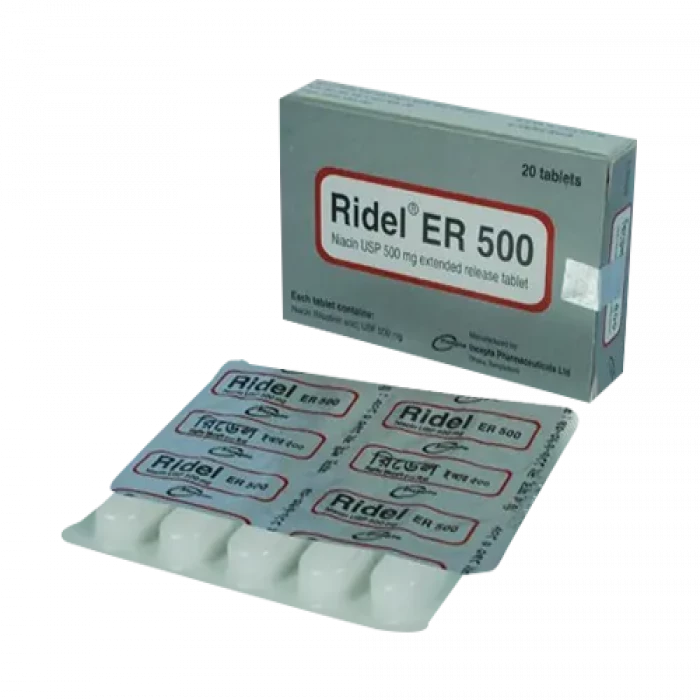Description:
Indications
For people whose risk of atherosclerotic vascular disease is significantly increased due to hyperlipidaemia, treatment with lipid-modifying agents should only be one component of interventions for multiple risk factors. When the response to a diet that restricts saturated fat and cholesterol and other non-pharmacological measures alone is insufficient, niacin therapy can be used as a dietary aid.
Niacin is suitable for reducing elevated TC, LDLC, Apo B, and TG levels and increasing HDLC in patients with primary hyperlipidemia and mixed dyslipidemia.
In patients with a history of myocardial infarction and hyperlipidaemia, niacin may reduce the risk of recurrence of non-fatal myocardial infarction.
In patients with a history of coronary artery disease (CAD) and hyperlipidemia, the combination of niacin and bile acid-binding resin may slow the progression of atherosclerotic disease or promote its regression.
Niacin combined with bile acid binding resin is used to reduce elevated levels of CT and LDLC in adult patients with primary hyperlipidemia.
Niacin is also suitable for the adjunctive treatment of adult patients with severe hypertriglyceridaemia who are at risk of pancreatitis and do not respond adequately to established dietary control.
Pharmacology
Nicotinic acid is converted into Niacin. It has been shown to reduce VLDL, LDL, total cholesterol, and triglyceride levels while increasing HDL. As a result, niacin has been prescribed to treat cardiovascular disease, notably hyperlipidemia.
Dosage & Administration
Niacin can be administered as a single dose at bedtime, after a snack or meal and doses should be individualized according to patient response. Therapy with Niacin must be initiated at 500 mg in order to reduce the incidence and severity of side effects which may occur during early therapy.
Maintenance Dose: The daily dosage of Niacin should not be increased by more than 500 mg in any 4-week period. The recommended maintenance dose is 1000 mg (two 500 mg tablets or one 1000 mg tablet) to 2000 mg (two 1000 mg tablets or four 500 mg tablets) once daily at bedtime. Doses greater than 2000 mg daily are not recommended. Women may respond at lower Niacin doses than men.
Single-dose bioavailability studies have demonstrated that two of the 500 mg and one of the 1000 mg tablet strengths are interchangeable but three of the 500 mg and two of the 750 mg tablet strengths are not interchangeable.
Flushing of the skin may be reduced in frequency or severity by pretreatment with aspirin (up to the recommended dose of 325 mg taken 30 minutes prior to Niacin dose). Tolerance to this flushing develops rapidly over the course of several weeks. Flushing, pruritus, and gastrointestinaldistress are also greatly reduced by slowly increasing the dose of niacin and avoiding administration on an empty stomach. Concomitant alcoholic, hot drinks or spicy foods may increase the side effects of flushing and pruritus and should be avoided around the time of Niacin ingestion.
Equivalent doses of Niacin should not be substituted for sustained-release (modified-release, timed-release) niacin preparations or immediate-release (crystalline) niacin. Patients previously receiving other niacin products should be started with the recommended Niacin titration schedule, and the dose should subsequently be individualized based on patient response.
If Niacin therapy is discontinued for an extended period, reinstitution of therapy should include a titration phase.
Niacin tablets should be taken whole and should not be broken, crushed or chewed before swallowing.
Interaction
The effects of ganglionic blocking agents and vasoactive medicines may be amplified by niacin, resulting in postural hypotension. Aspirin used at the same time may reduce nicotinic acid metabolic clearance. The therapeutic significance of this discovery is unknown. Colestipol bound about 98 percent of accessible Niacin, while cholestyramine bound 10 to 30 percent. These findings indicate that the intake of bile acid-binding resins and the delivery of Niacin be separated by 4 to 6 hours, or as much time as feasible.
Contraindications
Patients with a known hypersensitivity to Niacin or any of its components, severe or unexplained hepatic impairment, active peptic ulcer disease, or arterial bleeding should not use Niacin.
Side Effect
Niacin is typically well tolerated, with very minor and transitory side effects. Flushing, itching, pruritis, nausea and GI upset were the most common side effects, followed by jaundice, hypotension, tachycardia, elevated serum blood glucose and uric acid levels, and myalgia.
Pregnancy & Lactation
Patients with a known hypersensitivity to Niacin or any of its components, severe or unexplained hepatic impairment, active peptic ulcer disease, or arterial bleeding should not use Niacin.
Precautions & Warnings
Before starting niacin treatment, try to control hyperlipidemia through proper diet, exercise, and weight reduction in obese patients, and treat other potential medical problems. Patients with a history of jaundice, hepatobiliary disease, or peptic ulcer should be closely observed during niacin treatment. Liver function tests and blood sugar should be monitored frequently to ensure that the drug does not adversely affect these organ systems. Diabetes patients may experience increased dose-related glucose intolerance, the clinical significance of which is unclear. Patients with diabetes or potential diabetes should be closely monitored. May need to adjust diet and/or hypoglycemic therapy.
Caution should also be exercised when using niacin in patients with unstable angina or acute MI, especially when these patients are also receiving vasoactive drugs such as nitrates, calcium channel blockers, or adrenergic blockers. Niacin treatment can cause uric acid levels to rise, so it should be used with caution in patients prone to gout. Niacin was associated with a small but statistically significant dose-related decrease in platelet count and increase in prothrombin time. Caution should be exercised when niacin is administered with anticoagulants; the prothrombin time and platelet count of these patients should be closely monitored. Niacin is associated with a small but statistically significant dose-related reduction in phosphorus levels (an average reduction of 13% at 2000 mg). Therefore, phosphorus levels in high-risk patients should be monitored regularly.
Therapeutic Class
Vitamin-B preparations
Storage Conditions
Keep out of the reach of children.







Reviews
There are no reviews yet.